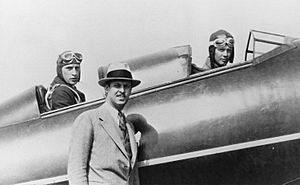Fred Weick facts for kids
Quick facts for kids
Fred Ernest Weick
|
|
|---|---|

Portrait of Fred E. Weick, 1936
|
|
| Born | July 14, 1899 |
| Died | July 8, 1993 (aged 93) |
| Nationality | US American |
| Alma mater | University of Illinois |
| Occupation | Aircraft Engineer |
| Employer | NACA Piper Aircraft Texas A&M University |
| Known for | NACA engine cowling Ercoupe |
| Spouse(s) | Dorothy Church (1900–1991) |
| Awards | Collier Trophy 1929 Daniel Guggenheim Medal (1989) |
Fred Ernest Weick (born 1899, died 1993) was a brilliant American engineer and aircraft designer. He started his career as an airmail pilot, flying planes that delivered mail. Later, he became a research engineer and designed many important parts for airplanes. He even designed whole aircraft!
Working at the National Advisory Committee for Aeronautics (NACA), he created something called the NACA cowling. This invention made planes much faster and more efficient. For this amazing design, he won the Collier Trophy in 1929, which is a very important award in aviation. Fred Weick also designed famous airplanes like the Ercoupe, the Piper PA-25 Pawnee, and the Cherokee. His work helped make flying safer and easier for everyone.
Contents
Fred Weick's Life and Aviation Innovations
Early Career and NACA Research
Fred Weick graduated from the University of Illinois in 1922. He was one of the first university graduates to use his engineering degree to work in aviation. He also became one of the first engineers hired by the early U.S. Air Mail Service. In the 1920s, he worked hard to set up emergency landing fields. These fields were very important for mail pilots flying at night.
In November 1925, Weick began working for the National Advisory Committee for Aeronautics (NACA). This was at their Langley Aeronautical Laboratory in Hampton, Virginia. He helped design the first wind tunnel used for testing full-size propellers. He also wrote a classic textbook about propeller design.
Making Planes Faster: The NACA Cowling
While at Langley, Fred Weick led the team that developed the NACA cowling. This was a special cover for airplane engines that made them more streamlined and reduced drag. This new technology greatly improved how planes performed.
The NACA cowling first changed civil air transport. It made planes faster and more profitable for airlines. It was also used on bombers and fighters during World War II. Because of this amazing engineering breakthrough, NACA won the prestigious Collier Trophy in 1929.
Designing Safer Aircraft: The Ercoupe
Fred Weick was very passionate about making flying safer. In the early 1930s, he built an experimental airplane to show his ideas for safety. In 1936, he left NACA and joined ERCO's new aircraft team as their chief designer.
His main goal was to make flying as easy and safe as driving a car. He designed planes with simple controls. He also added tricycle landing gear, which has a nose wheel and two main wheels. This design later became standard on most aircraft around the world.
Later in the 1930s, Weick improved his design with the Ercoupe. This was a two-seat, all-metal airplane with low wings. It was so easy and safe to fly that many students learned to fly it in five hours or less. Even decades later, many of the 6,000 Ercoupes built were still flying. In 1946, he received the Fawcett Aviation Award. This award recognized his work on a "spinproof, stallproof, all-safety" light plane that was as easy to fly as a car.
Planes for Farmers: Crop Dusters
In 1948, Fred Weick joined Texas A&M University. There, he worked on designing and developing the Ag-1 crop duster. This type of plane sprays crops in fields. He also designed the Ag-3, which was the plane before the Piper PA-25 Pawnee series. The basic ideas from the Ag-1 can still be seen in modern crop dusters today, like the Air Tractor AT-802.
Later Work at Piper Aircraft
In 1957, Weick joined Piper Aircraft as the director and chief engineer of their development center. He stayed there until he retired at age 70. Besides the Pawnee, Weick also helped design Piper's Cherokee line of personal and business light aircraft.
Even after retiring, Fred Weick stayed active in general aviation. He regularly attended the Experimental Aircraft Association Oshkosh airshow. He enjoyed the entertainment and lectures there.
Fred Weick's Legacy
Fred Weick married Dorothy Church (1900–1991), and they had three children. He passed away on July 8, 1993, in Vero Beach, Florida.
In 2002, Fred E. Weick was honored by the Virginia Aeronautical Historical Society. He was inducted into the Virginia Aviation Hall of Fame. This recognized his many important contributions to aviation and making flying safer.
Gallery
-
1929 Collier Trophy: President Hoover presents the award to NACA's Chairman Joseph Ames for the NACA cowling
-
Eddie Rickenbacker (left) presents the Fawcett Aviation Award to Fred E. Weick (right), January 1946










